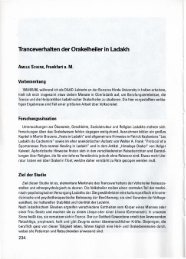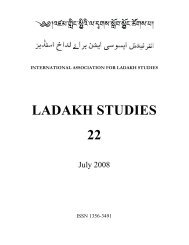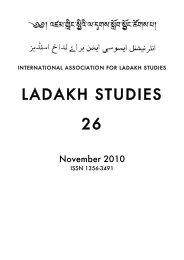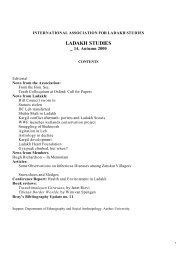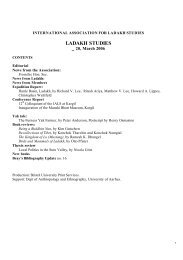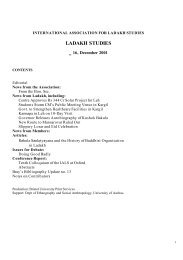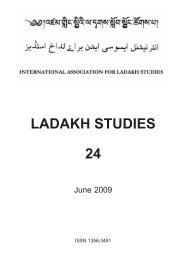LADAKH STUDIES 12, Autumn 1999 - International Association for ...
LADAKH STUDIES 12, Autumn 1999 - International Association for ...
LADAKH STUDIES 12, Autumn 1999 - International Association for ...
Create successful ePaper yourself
Turn your PDF publications into a flip-book with our unique Google optimized e-Paper software.
DISSERTATION ABSTRACTS<br />
Mallon, David P. Ecology and Conservation of Mountain Ungulates in Ladakh, India. Ph.D. thesis,<br />
Manchester Metropolitan University, 1998. Pp. x+2<strong>12</strong>, incl. maps, figs.<br />
Research was carried out in a 15,000 km2 study area in central Ladakh, India. The study area is<br />
Transhimalayan in character with ecological affinities to Tibet and Central Asia. The main study<br />
species were Ladakh urial Ovis vignei, bharal Pseudois nayaur and Himalayan ibex Capra sibirica,<br />
with additional data collected on two species occurring marginally within the study area, argali Ovis<br />
ammon and kiang Equus kiang. Distributions were mapped in detail. Distribution of urial was<br />
restricted to a band along the Indus valley and its tributaries. Bharal and ibex were widely<br />
distributed and apparently share the study area. Bharal occur in the eastern part of the Zanskar<br />
Range and across the eastern plateau of Ladakh. Ibex occur mainly in the western part of the<br />
Zanskar range, along the northern slopes of the Himalayan range and the southern slopes of the<br />
Ladakh range. Argali and kiang occur across eastern Ladakh and just reach the eastern edge of the<br />
study area; both have occasionally established a presence farther west. Current estimated numbers<br />
in the study area were: 500-700 urial; 6,000-10,000 bharal, 3150-6150 ibex,




